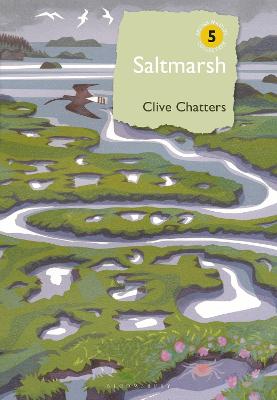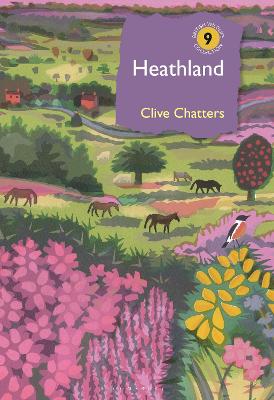British Wildlife Collection
2 total works
“Saltmarshes are often remote, inhospitable places, neither land nor sea, as hard to pin down as they are to navigate. In this saline odyssey, Clive Chatters has explored his favourite creeks, pools and mudflats to bring us an absorbing celebration of the ecology, biology, geology and history of this scarce and mysterious habitat. There are Tadpole Shrimps, and rare sedges, waders and Wild Celery – even inland saltmarshes – in this tour de force by a superb naturalist and writer.“
BRETT WESTWOOD, naturalist, author and radio presenter
Saltmarshes are among Britain’s most diverse and dynamic landscapes. They abound around our shores but may also be found inland and at altitude – wherever water, salt and vegetation combine. The species they support range from extreme rarities of specialised habitats to the less demanding denizens of coastal wetlands. Here is a landscape of international importance for migratory birds, endemic plants and an exceptional variety of invertebrates.
Clive Chatters has a lifetime’s affinity with saltmarshes. In this fifth volume of the British Wildlife Collection, he celebrates their natural history and diversity, from the highly distinctive marshes in the Scottish Highlands to the urban remnants of the Thames estuary now engulfed within the capital. By examining the past of these complex habitats, we can gain an insight into how they have developed, and an understanding of their relationship with people. In addition to their exceptionally diverse natural history, saltmarshes are sources of food and medicine, they play a pivotal role in flood defence and carbon sequestration, and have inspired artistic endeavour.
BRETT WESTWOOD, naturalist, author and radio presenter
Saltmarshes are among Britain’s most diverse and dynamic landscapes. They abound around our shores but may also be found inland and at altitude – wherever water, salt and vegetation combine. The species they support range from extreme rarities of specialised habitats to the less demanding denizens of coastal wetlands. Here is a landscape of international importance for migratory birds, endemic plants and an exceptional variety of invertebrates.
Clive Chatters has a lifetime’s affinity with saltmarshes. In this fifth volume of the British Wildlife Collection, he celebrates their natural history and diversity, from the highly distinctive marshes in the Scottish Highlands to the urban remnants of the Thames estuary now engulfed within the capital. By examining the past of these complex habitats, we can gain an insight into how they have developed, and an understanding of their relationship with people. In addition to their exceptionally diverse natural history, saltmarshes are sources of food and medicine, they play a pivotal role in flood defence and carbon sequestration, and have inspired artistic endeavour.
‘In Clive, we have an ever-fascinating guide to Britain’s heathery districts, not only marvelling at the wildlife of such wild places, but also celebrating their diverse origins, uses and cultural resonances’ - Andrew Byfield
Heathlands are so much more than simply purple carpets of heather. They are ancient landscapes found throughout Britain that support a complex of inter-related species and an immense diversity of habitats. They also possess a unique human history defined by the struggle between pastoralism and the competing demands of those who seek exclusive use of the land.
In this latest addition to the British Wildlife Collection, Clive Chatters introduces us to Britain’s heathlands and their anatomy. He then takes the reader on a geographical heathland tour – from the maritime sub-arctic of the Shetlands to the mild wetness of the Atlantic coast – with an in memoriam nod to those heaths that have been erased from common memory and understanding. He concludes with a review of how people have perceived and used heathland wildlife over the ages, and sets out a future vision for this iconic landscape, its unique habitats and the species that live there.
Most of our heaths are pale shadows of their former selves. However, Chatters argues, it is not inevitable that the catastrophic losses of the recent past are the destiny of our remaining heaths. Should we wish, their place in the countryside as an integral part of British culture can be secured.
Heathlands are so much more than simply purple carpets of heather. They are ancient landscapes found throughout Britain that support a complex of inter-related species and an immense diversity of habitats. They also possess a unique human history defined by the struggle between pastoralism and the competing demands of those who seek exclusive use of the land.
In this latest addition to the British Wildlife Collection, Clive Chatters introduces us to Britain’s heathlands and their anatomy. He then takes the reader on a geographical heathland tour – from the maritime sub-arctic of the Shetlands to the mild wetness of the Atlantic coast – with an in memoriam nod to those heaths that have been erased from common memory and understanding. He concludes with a review of how people have perceived and used heathland wildlife over the ages, and sets out a future vision for this iconic landscape, its unique habitats and the species that live there.
Most of our heaths are pale shadows of their former selves. However, Chatters argues, it is not inevitable that the catastrophic losses of the recent past are the destiny of our remaining heaths. Should we wish, their place in the countryside as an integral part of British culture can be secured.

